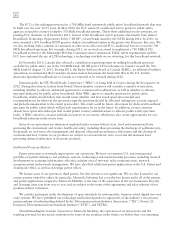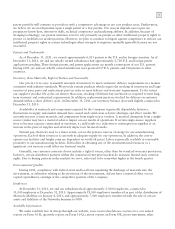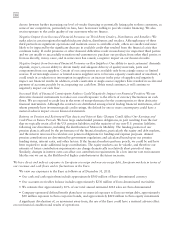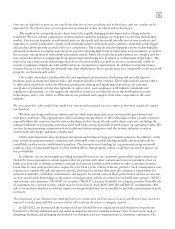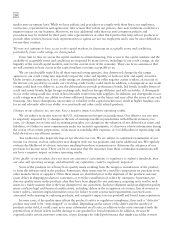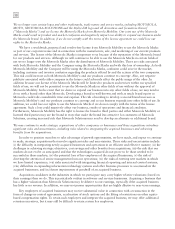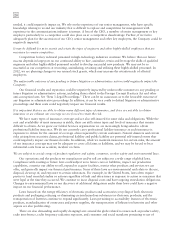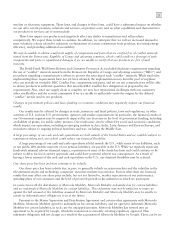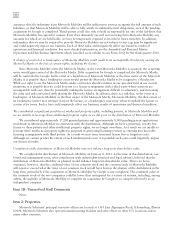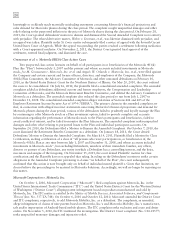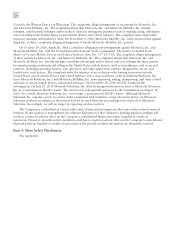Motorola 2011 Annual Report Download - page 22
Download and view the complete annual report
Please find page 22 of the 2011 Motorola annual report below. You can navigate through the pages in the report by either clicking on the pages listed below, or by using the keyword search tool below to find specific information within the annual report.
16
promote our products, or changes in the financial or business condition of these distributors, representatives or
retailers, could affect our ability to bring products to market.
Our future operating results depend on our ability to purchase a sufficient amount of materials, parts and
components to meet the demands of our customers and any reduction or interruption in supplies or significant
increase in the price of supplies could have a negative impact on our results of operations.
Our ability to meet customers’ demands depends, in part, on our ability to obtain timely and adequate delivery
of quality materials, parts and components from our suppliers. If demand for our products increases from our
current expectations or if suppliers are unable to meet our demand for other reasons, including as a result of natural
disasters or financial issues, we could experience shortages. We have experienced shortages in the past, including
recently as a result of the earthquake and tsunami in Japan and flooding in Thailand, that have negatively impacted
our results of operations. Although we work closely with our suppliers to avoid shortages, there can be no assurance
that we will not encounter shortages in the future or that such shortages will not negatively impact our results of
operations.
Furthermore, certain of our components are available only from a single source or limited sources. We may not
be able to diversify sources in a timely manner. A reduction or interruption in supplies or a significant increase in
the price of supplies could have a negative impact on our business. In addition, our current contractual
arrangements with certain suppliers may be cancelled or not extended by such suppliers and, therefore, not afford us
with sufficient protection against a reduction or interruption in supplies. Moreover, in the event any of these single
source or limited source suppliers breach their contracts with us, our legal remedies associated with such a breach
may be insufficient to compensate us for any damages we may suffer.
We rely on complex information technology systems and networks to operate our business. Any significant system
or network disruption, including as a result of third party attacks, could have a negative impact on our operations,
sales and operating results.
We rely on the efficient and uninterrupted operation of complex information technology systems and networks,
some of which are within the Company and some are outsourced. All information technology systems are
potentially vulnerable to damage or interruption from a variety of sources, including but not limited to computer
viruses, security breach, energy blackouts, natural disasters, terrorism, war and telecommunication failures. As a
provider of high technology emergency response systems, we face additional risk as a target of sophisticated attacks
aimed at compromising our intellectual property, referred to as advanced persistent threats. In addition, we plan to
implement a number of significant business systems upgrades in 2012 which, if defective or improperly installed or
implemented may result in a business disruption. A system failure or security breach could negatively impact our
operations and financial results. In addition, we may incur additional costs to remedy the damages caused by these
disruptions or security breaches.
There has been a sharp increase in laws in Europe, the U.S. and elsewhere imposing requirements for the
handling of personal data. There is a risk that failures in systems designed to protect private, personal or proprietary
data held by us will allow such data to be disclosed to or seen by others, resulting in application of regulatory
penalties, remediation obligations and/or private litigation by parties whose data were disclosed.
We face many risks relating to intellectual property rights.
Our business will be harmed if: (i) we, our customers and/or our suppliers are found to have infringed
intellectual property rights of third parties, (ii) the intellectual property indemnities in our supplier agreements are
inadequate to cover damages and losses due to infringement of third-party intellectual property rights by supplier
products, (iii) we are required to provide broad intellectual property indemnities to our customers, (iv) our
intellectual property protection is inadequate to protect against threats of misappropriation from internal or
external sources or otherwise inadequate to protect our proprietary rights, or (v) our competitors negotiate
significantly more favorable terms for licensed intellectual property. We may be harmed if we are forced to make
publicly available, under the relevant open-source licenses, certain internally developed software-related intellectual
property as a result of either our use of open-source software code or the use of third-party software that contains
open-source code.


